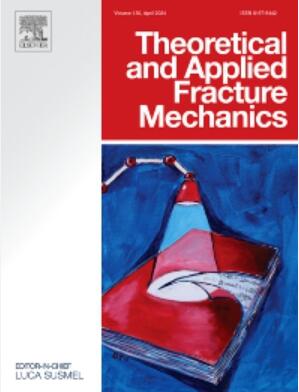Using sand 3D printing, digital image processing technology and DEM to investigate rock hole-fissure interaction mechanisms
IF 5
2区 工程技术
Q1 ENGINEERING, MECHANICAL
引用次数: 0
Abstract
Holes and fissures in rocks significantly influence rock engineering stability. This study employed sand 3D printing to create specimens with various hole-fissure combinations. Uniaxial compression tests were conducted, and DIC and DEM were used to analyze crack propagation. Results showed that seven crack types were identified. The single hole-fissure specimen had the highest peak strength, while in double hole-fissure specimens, peak strength increased with larger vertical hole distance d and fissure angle α. The number of cracks was inversely proportional to peak strength, decreasing as d increased and dropping sharply when α ranged from 30° to 60°. Crack initiation mechanisms under different circumstances were discussed. The research findings can provide valuable insights for accurately understanding the fracture mechanisms of rock masses containing hole-fissure combination structures and serve as a reference for predicting and preventing rock engineering disasters. Meanwhile, the research comprehensively adopted sand 3D printing, DIC technology and DEM to study the hole-fissure interaction mechanisms, providing a new method to efficiently study the mechanisms of rock failure.
利用砂石3D打印、数字图像处理技术和DEM研究岩石孔-裂隙相互作用机理
岩石中的孔洞和裂隙对岩石工程稳定性有重要影响。本研究采用砂体3D打印技术来制作各种孔缝组合的样品。进行单轴压缩试验,采用DIC和DEM分析裂纹扩展。结果表明,共鉴定出7种裂纹类型。单孔裂隙试件峰值强度最高,双孔裂隙试件峰值强度随垂向孔距d和裂隙角α的增大而增大。裂纹数量与峰值强度成反比,随着d的增大而减少,当α在30°~ 60°范围内急剧下降。讨论了不同条件下的裂纹萌生机制。研究结果可为准确认识含孔缝组合结构岩体的断裂机制提供有价值的见解,为预测和预防岩石工程灾害提供参考。同时,综合采用砂土3D打印、DIC技术和DEM技术研究孔-裂隙相互作用机理,为有效研究岩石破坏机理提供了新方法。
本文章由计算机程序翻译,如有差异,请以英文原文为准。
求助全文
约1分钟内获得全文
求助全文
来源期刊

Theoretical and Applied Fracture Mechanics
工程技术-工程:机械
CiteScore
8.40
自引率
18.90%
发文量
435
审稿时长
37 days
期刊介绍:
Theoretical and Applied Fracture Mechanics'' aims & scopes have been re-designed to cover both the theoretical, applied, and numerical aspects associated with those cracking related phenomena taking place, at a micro-, meso-, and macroscopic level, in materials/components/structures of any kind.
The journal aims to cover the cracking/mechanical behaviour of materials/components/structures in those situations involving both time-independent and time-dependent system of external forces/moments (such as, for instance, quasi-static, impulsive, impact, blasting, creep, contact, and fatigue loading). Since, under the above circumstances, the mechanical behaviour of cracked materials/components/structures is also affected by the environmental conditions, the journal would consider also those theoretical/experimental research works investigating the effect of external variables such as, for instance, the effect of corrosive environments as well as of high/low-temperature.
 求助内容:
求助内容: 应助结果提醒方式:
应助结果提醒方式:


